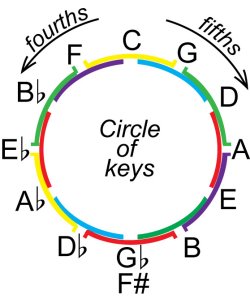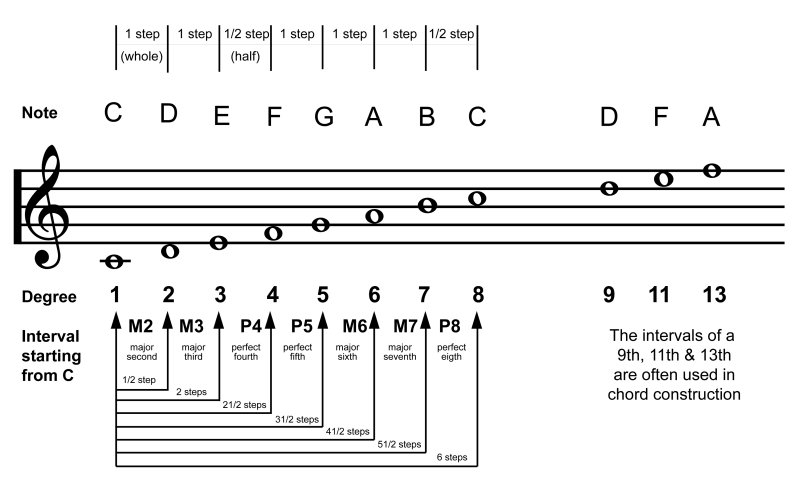Terminology
arpeggio: the sequential playing of the notes of a chord.
cadence: a two chord progresion from the V7 of a scale to the tonic I of that scale, for example in the key of C major G7 - C;
a cadence allows the composer to establish the key as being the current tonal center.
CAGED: the 5 chord forms of the guitar, all chords can be played using one of these 5 forms.
capo: a mechanical device (vise) that holds all the strings down at once at a particular fret position on the guitar; from the italian
capo tasto meaning head stop. The capo allows the player to change key while retaining the same chord forms.
chord: 3 or more notes played at the same time.
chord root or tonic: the note form which the chord gets its name. For example the root
of the G major chord is G.
chord quality or type: this is indicated by the chord suffix. For example the chord
Bm7♭5, the root is B and the quality is m7♭5.
chromatic: sequentially all 12 notes in a scale for example, C, C#, D, D#, E, F, etc...
circle of fifths: this is a sequential relationship between keys that are separated by a fifth which
is also called a perfect fifth interval. This interval is pleasant to hear at least in Western culture.

diatonic: belonging to a scale.
interval: the distance between any two notes. Altough there are many types of intervals,
there are only five categories: major, minor, perfect, augmented and diminished.
Interestingly the major scale contains only the major and perfect intervals.
falling fifths: a popular chord progression in songs is the falling fifths, this is very pleasant to the ear because of the continual
interval of the perfect fifth between the root of each chord, each fifth is a secondary dominant of the initial key. When the song uses
the falling fifths chord sequence within the scale it is called a diatonic falling fifths and this is also quite popular.
flat: for a note means to lower it by 1 half-tep, for a chord it means to lower all notes by a half-step.
key: the root or tonic of a song.
major: in the case of a scale denotes a particular pattern of interval between notes, step, step, half-step, step, sterp, step, half-step is the pattern of a major scale;
in the case of a chord denotes the intervals between the notes, a major 3rd (1-3) for the first two notes and a perfect 5th (1-5) for the 1st and last note of a 3-note chord.
minor: in the case of a scale denotes a particular pattern of interval between notes, step, half-step, step, tone, half-step, step, step is the pattern of a minor scale;
in the case of a chord denotes the intervals between the notes, a minor 3rd (1-b3) for the first two notes and a perfect 5th (1-5) for the 1st and last note of a 3-note chord.
modes: Either of the two octave arrangements in modern music. The modes are either major or minor.
modulation: To shift to another key or scale.
natural: A symbol in sheet music that returns a note to its original pitch after it has been augmented or diminished.
octave: Eight full tones above the key note where the scale begins and ends.
phrase: A single line of music played or sung. A musical sentence.
pitch: The frequency of a note determining how high or low it sounds.
relative major and minor: The major and minor keys that share the same notes in that key. For example: A minor shares the same note as C major.
rhythm: The element of music pertaining to time, played as a grouping of notes into accented and unaccented beats.
root: the principal note of a triad chord, or in the scale of a scale the first note.
scale: successive notes of a key or mode either ascending or descending.
secondary dominant: any chord in the major scale except for the diminished chord can be used a secondary dominant. The secondary dominant may be used to
establish a new key or as a passing chord. The secondary dominant is usually played as a seventh providing lots of tension helping resolve to the tonic of the new key thereby establishing that
new key in the mind of the listener.
semi-tone: the shortest interval between 2 notes on the chromatic scale, for example between C and C#.
sharp: a symbol indicating the note is to be raised by one semitone.
staff: made up of five horizontal parallel lines and the spaces between them on which musical notation is written.
step: play any note on the guitar and then play the note (on the same string) one
fret above it. The distance between these two notes is a half-step. A whole step is
two notes that are two frets apart.

tablature: a system of notation for stringed instruments. The notes are indicated by the finger positions.
tonal center: this is the key of a song, in particular for complex songs structures that have a lot of modulation or changes between keys
it is the original key or key to which the composer will return and often finish in.
tonicisation: a short lived change to another key where only one or two chords of the new key are played before returning ot the initial key.
Tone: an interval corresponding to 2 semi-tones or half-tones.
tonic: The first tone of a scale also known as a keynote.
triad: three note chords consisting of a root, third, and fifth.
tritone: a chord comprised of three whole tones resulting in an augmented fourth or diminished fifth.
For more specific guitar related terms see: http://www.melbay.com/Pages/Item/3226/Glossary-Of-Guitar-Terms.aspx